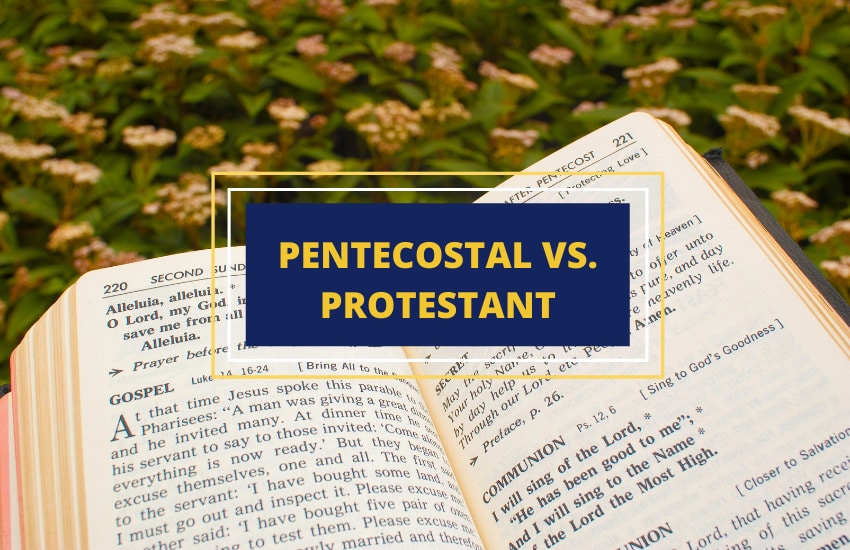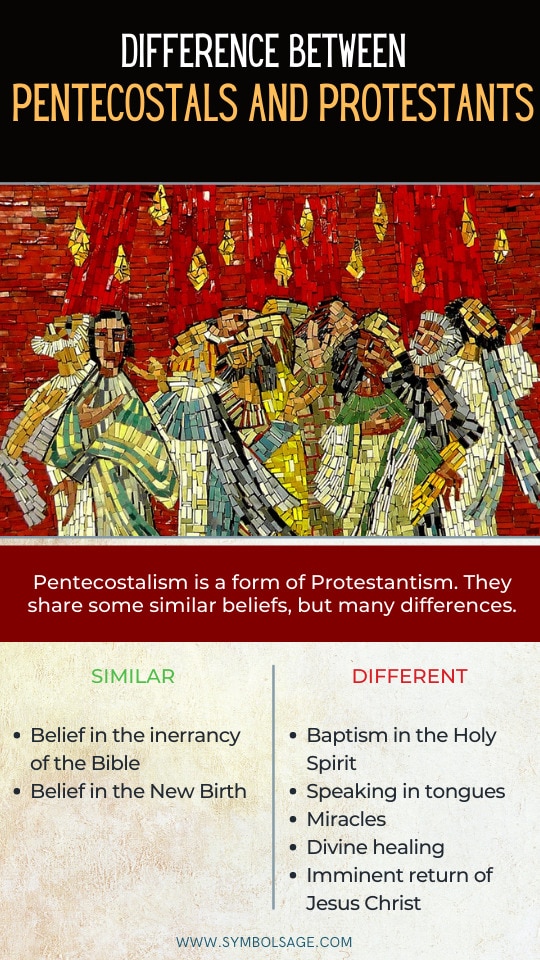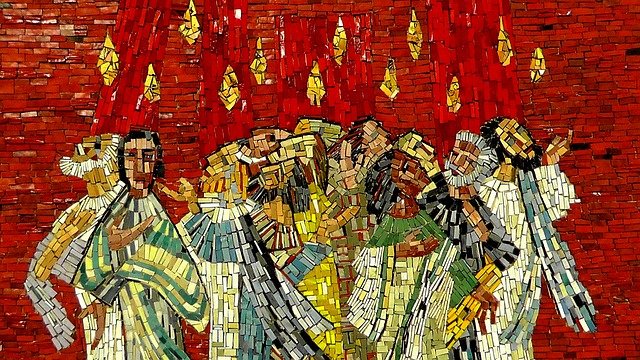
Table of Contents
Pentecostalism is one of the fastest-growing religious movements in the world today, with more than 600 million adherents worldwide. This number represents members of Pentecostal denominations and Christians of other denominations that identify with Pentecostal/Charismatic beliefs.
Pentecostalism is less a denomination and more a movement within Christianity. For this reason, it is difficult to separate it from other groupings within Christianity, such as Catholic, Eastern Orthodox, or Protestant.
How has it proliferated in just over 100 years? This is attributable mainly to its focus on experiential faith and vibrant, energetic worship, which starkly contrasts the Protestantism found in America into the 1900s.

Pentecostal vs. Protestant
Protestants are a very broad group and comprises several denominations, including Lutherans, Anglicans, Baptists, Methodists, Adventists, and Pentecostals. In many ways, Pentecostalism is a part of Protestantism.
Some similar beliefs between Pentecostalism and other forms of Protestantism include:
- The belief that the Bible has no fault or error and is the true word of God.
- The belief in being born again by repenting of your sins and accepting Jesus as your personal Lord and Savior.
Yet, certain features of the Pentecostal belief differentiate it from the Protestantism that preceded its arrival in the early 20th century.
The main differences are that Pentecostals believe:
- In the baptism in the Holy Spirit which enables followers to live a life filled with the ‘Spirit’
- In spiritual gifts, such as speaking in tongues, miracles, and divine healing, which likens the spirituality and teachings of the current movement to those of the Apostolic Age
Beginnings of Pentecostalism
The influence of America’s puritan heritage is long-standing in Protestant churches. Before the turn of the 20th century, church worship was highly regulated and emotionless. The emphasis on a Sunday morning was on propriety of behavior, solemnity, and learning theological doctrine.
The only real religious exception to this was found in the revival. Revivals regularly swept over parts of the eastern United States in the first few centuries after the arrival of European colonists. The most notable of these are the First and Second Great Awakening of the 1730s and early 1800s respectively.
Revival meetings became a popular tool for reaching rural parts of the country, especially in the South. Men such as George Whitfield, John, and Charles Wesley made names for themselves as traveling preachers, taking their message to places without full-time clergy. This tradition provided the environment for new forms of worship.
Revival meetings were more experientially driven and, therefore, more exciting. They attracted people based on this excitement, not concerned if someone showed up just for the entertainment because that person would hear the message and perhaps be converted.
The event most often used to mark the beginning of the modern Pentecostal movement is the Azusa Street Revival of 1906. It was there, in a former AME church, that William J. Seymor’s preaching launched the worldwide movement.
Prior to this event, the ideas which spawned Pentecostalism were germinating in various regions of the United States, primarily among the poorer populations of rural southern white communities and urban African American communities.
The movement has its roots in the holiness movement revivals of the late 1800s around North Carolina, Tennessee, and Georgia. The man responsible for disseminating what became the key beliefs of Pentecostalism was Charles Parham. Parham was an independent revivalism preacher who advocated for divine healings and promoted speaking in tongues as evidence of the “baptism of the Holy Spirit”.
At the turn of the 20th century, Parham opened a school in Topeka, KS, where he taught these ideas to his students. Agnes Ozman, one of the students, is noted as the first person to speak in tongues. In 1901 Parham closed his school.
After another stint as a traveling revivalist, he opened a Bible training school in Houston, Texas. This is where Seymor came into contact with Parham. An African American with one eye, Seymor was a student of Parham and afterward left for Los Angeles, where he began preaching. The Azusa Street Revival began soon after his arrival on the West Coast.
Distinctive Beliefs of Pentecostalism

The main beliefs of Pentecostalism are:
- Baptism by the Holy Spirit
- Speaking in tongues
- Divine healing
- Imminent return of Jesus Christ
The most distinctive belief of Pentecostalism is the belief in a baptism by the Holy Spirit. In conjunction with this is the belief that speaking in tongues is the evidence of this spiritual baptism.
These two beliefs are taken from the Acts of the Apostles in the New Testament. Chapter two tells of events in the early church occurring on the Day of Pentecost, the Jewish Feast of Weeks celebrating the end of the harvest.
According to Acts 2:3-4, Jesus’ early followers were together worshipping, when “there appeared to them tongues as of fire, distributed and resting on each one of them. And they were all filled with the Holy Spirit and began to speak in other tongues”. They then went into Jerusalem, declaring the message of Jesus in different languages to the crowds gathered from all over the Roman empire. This event culminated in the conversion of over 3,000 people.
Pentecostalism elevates these events from a descriptive story to prescriptive expectation. Protestants and other Christians did not see that this sort of filling by the Holy Spirit was common nor speaking in tongues. Pentecostals view these as necessary experiences to be expected by all believers after conversion.
Divine healing is another distinctive marker of Pentecostal belief. The healing of sickness and disease found in the New Testament is again prescriptive rather than descriptive for Pentecostals. These healings happen through prayer and faith. They are evidence of the return of Jesus when he will do away with sin and suffering.
This builds on another Pentecostal belief, that of the imminent return of Christ. Pentecostals emphasize the idea that Jesus could return at any moment, and we are essentially always living in the last days.
All of these beliefs land in the discussion of what is called spiritual gifts. This term is taken from Paul’s writings, particularly 1 Corinthians 12. Here Paul refers to “varieties of gifts, but the same Spirit”. These gifts include wisdom, knowledge, faith, healing, prophecy, speaking in tongues, and interpreting tongues. What these gifts mean and how they manifest is an ongoing theological debate within Christianity.
Pentecostal Influence

Someone reading this summary of Pentecostal beliefs may be saying to themselves, “These are not that different from what my church or the church I grew up in believes. I didn’t know they were Pentecostal.”
What this speaks to is the influence of Pentecostalism throughout Christian denominations. As stated earlier, Pentecostalism is less of a distinct denomination and much more of a movement. Parts or all these beliefs influence churches of all denominations. Today, for instance, it is much more popular to be “continuationist” in the Pentecostal tradition rather than a “cessationist” in the old Protestant tradition when it comes to spiritual gifts.
- Cessationists advocate for the cessation of some spiritual gifts after the death of the apostles. In this view, things such as tongues and healings no longer occur.
- Continuationists take the opposite view, a view given popular rise by Pentecostalism.
Pentecostal influence is also found in the popular worship music sung in most Protestant evangelical churches. These songs may ask for God’s presence or welcome him to come and meet with the people. Lyrics focused on the Spirit and miracles. These come from the Pentecostal experiential worship tradition.
And it is no surprise, considering some of the largest and most influential mega-churches in the world are Pentecostal. Hillsong Church, for example, is a charismatic church in the Pentecostal tradition.
Founded in 1983 in the suburbs of Sydney, Australia, the church now boasts campuses worldwide with 150,000 members in 23 countries. It is perhaps best known for its worship songs, albums, and concerts. Hillsong Worship, Hillsong United, Hillsong Young and Free, and Hillsong Kids are various forms of their music.
FAQs About Pentecostal vs. Protestant
The Pentecostal church emphasizes the believer’s direct experience of God as well as the work of the Holy Spirit.
This denomination is based on the baptism of the twelve disciples on the day of Pentecost, as outlined in the book of Acts.
The gifts of the Spirit such as speaking in tongues, healing, miracles, or prophecy are believed to be the direct experience of God revealing itself.
No, it’s more a movement than a church. It includes several churches, such as Hillsong Church.
Yes, Pentecostals believe the Bible is the word of God and is free of any error.
In Brief
The differences between Pentecostalism and Protestantism are more historical than fundamental distinctions. The more Pentecostal beliefs and expressions of worship influence Christianity globally, the less visible these differences become.
Few Protestants today would be able to distinguish Pentecostal beliefs from their own faith traditions. Whether this influence is good or bad is a discussion worth having. Still, the confluence of Pentecostalism and traditional Protestantism looks to only increase in the future.








